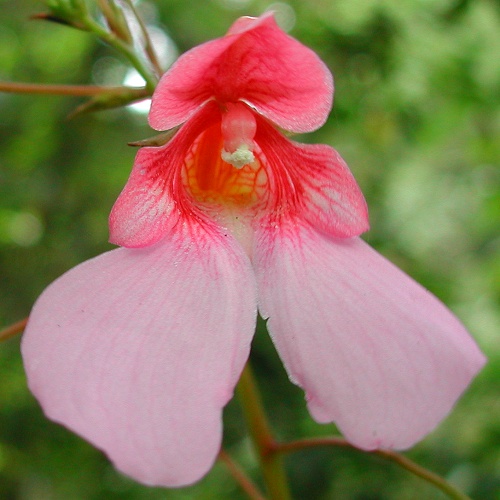| Home |
Strange Wonderful Things Rare and exotic plants |
 |
|---|
Germinating the seeds
When to plant -- Plant your seeds when you receive them for best germination.
Getting started -- For soil, use a well draining mix. A typical mix is 2 parts potting soil to 1 part
perlite or
coarse sand. An alternate mix is 1 perlite to 1 part coir fiber or
peat moss, with some granular fertilizer that contains micronutrients.
Fill the pots with soil and place a seed or 2 on the surface, and cover with a
very thin layer of soil (1/8th inch / 2mm Add water until everything is evenly moist (but not soggy).
Until the seeds sprout, ensure that the surface soil always stays moist. If you enclose the pots to maintain moisture, leave it open slightly to allow some fresh air in, to prevent stem rot later on. You may need to drip a few drops of water over the seeds each day to keep the seeds moist.
Until they sprout, try to keep them between 65 and 77 degrees F (18-25°C) during the day, and between 50 and 70°F (10-21°C) at night. Avoid letting them get above 80° F (27°C). I recommend placing a minimum/maximum thermometer near the pots.
Keep them in bright light out of
direct sun. A bright LED or fluorescent bulb kept 4 inches (10 cm) away provides
the right amount of light (See: "Growing indoors with LED lights").
They should start germinating in about 6 to 8 weeks, but may take up to 16 weeks
to start.
Increase air ventilation slightly after sprouting to prevent rot, but continue keeping the
soil surface moist for 2-3 weeks after sprouting.
Growing onward...
Lighting -- This Impatiens prefers bright shade, or filtered sunlight.
Protect it from strong afternoon sun.
Watering -- Aim to keep the soil moist, but not soggy. Never let it dry out completely. You may use a moisture meter probe to monitor the moisture levels down in the root zone.
Fertilizing -- The first 6 weeks, feed weekly with a small amount of dilute
(1/8 strength) liquid fertilizer.
Hydroponic fertilizer
is ideal for young seedlings, since it is easily absorbed and contains all
essential nutrients.
After 6 weeks, you may switch to a granular fertilizer that contains
micronutrients, feeding at half the dosage on the package. Or continue
feeding weekly with some dilute liquid fertilizer.
Transplanting -- When your plants are 2-3 months old, you may gently
transfer them to a larger pot.
As the plant grows larger, its tubers increase in size very
rapidly, so occasionally dig down to the tuber to determine when they are
nearing the edge of the pot, indicating it is time to
repot. Failure to check on the tubers may lead to broken pots! The
pots you use don't need to be very tall but they should be wide, since the
tubers mostly grow sideways.
Humidity - If grown indoors, and your room humidity is under 40%, consider using an ultrasonic room humidifier, which you can buy
inexpensively at places like Home Depot and thrift shops.
Pruning -- Pruning isn't necessary. This Impatiens often makes a single main stem with few side branches. Pruning the top will encourage the side branches to grow fuller.
Dormancy care -- Indoors, the plants may stay evergreen all year, but outdoors it tends to go dormant in winter if temperatures go below about 40° F (5°C). If it does go dormant, ensure that the soil does not dry out completely during the winter.
If you pull the bulbs up to separate them, place them back into lightly-moist soil, so they do not dry out. The bulbs are fairly rot-proof, but avoid letting the soil get too wet while dormant. It tends to come out of dormancy around April here in California.
Outdoors, the dormant tubers are hardy down the low-20s (-5°C) if planted deep and kept dry, although it's probably best to bring the pot indoors for the winter.
Pests to watch for - Look for any pests that can affect your other plants.
If you have any questions, feel free to contact me.
- Jeff
Strange Wonderful Things
| Home |
Strange Wonderful Things Rare and exotic plants |
|
|---|---|---|
| Entire site Copyright 2003-2025 by Strange Wonderful Things, except as noted | ||

